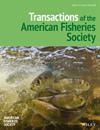新墨西哥州明布雷斯河 Chihuahua Chub 的种群生存能力分析
IF 1.4
3区 农林科学
Q2 FISHERIES
引用次数: 0
摘要
目标吉娃娃鲦鱼 Gila nigrescens 在其整个分布区都是受保护的物种。该物种受到栖息地退化、非本地物种和随机事件(如野火和干旱)的威胁。为了解决这些不确定性,我们收集了 Mimbres 河中 Chihuahua Chub 的种群人口和动态数据,并利用这些数据构建了一个基于年龄结构的雌性种群模型。该模型用于评估奇瓦瓦鲢对 (1) 生境改善、(2) 保护性放养和 (3) 随机事件的响应。栖息地改善被模拟为当前丰度的 50%增长。保护性放养由两种放养制度组成:每年放养 200 尾 "维持性 "鱼类或在随机事件发生后连续两年放养 400-1500 尾 "灾难性 "鱼类。随机事件的影响表现为年存活率下降 20-95%。结果 在没有采取保护措施的情况下,奇瓦瓦鲢的数量预计会因随机事件而下降。然而,放养和栖息地改善降低了灭绝的风险。当随机事件导致年存活率下降 95% 时,相对于不采取保护性放养措施,灾难性放养可使种群数量下降 47-58%。总之,我们的研究结果表明,面对未来的随机事件,增加栖息地和保护性放养可能是保护奇瓦瓦鲢最有效的方法。本文章由计算机程序翻译,如有差异,请以英文原文为准。
Population viability analysis of Chihuahua Chub in the Mimbres River, New Mexico
ObjectiveThe Chihuahua Chub Gila nigrescens is a species of conservation concern throughout its distribution. The species is threatened by habitat degradation, nonnative species, and stochastic events (e.g., wildfire and drought). Although conservation efforts are ongoing, it is unclear how Chihuahua Chub in the Mimbres River, New Mexico, respond to conservation actions and stochastic events.MethodsTo address these uncertainties, we collected population demographic and dynamics data on Chihuahua Chub in the Mimbres River and used the data to construct an age‐structured, female‐based population model. The model was used to evaluate the response of Chihuahua Chub to (1) habitat improvement, (2) conservation stocking, and (3) stochastic events. Habitat improvements were modeled as a 50% increase in current abundance. Conservation stocking was represented by two stocking regimes: annual “maintenance” stocking of 200 fish or “catastrophe” stocking of 400–1500 fish for two consecutive years after a stochastic event. The effects of stochastic events were represented by 20–95% reductions in annual survival. Each scenario was simulated for 5000 iterations over 25 years.ResultIn the absence of conservation actions, the Chihuahua Chub population was projected to decline due to stochastic events. However, stocking and habitat improvement decreased the risk of extirpation. When stochastic events resulted in a 95% decline in annual survival, catastrophe stocking reduced population declines in abundance by 47–58% relative to no conservation stocking. When stochastic events caused a 20% reduction in annual survival, habitat improvement increased the median population size after 25 years by almost 50% relative to no habitat improvements.ConclusionCollectively, our results suggest that an increase in habitat and conservation stocking efforts is likely the most effective approach for conserving Chihuahua Chub in the face of future stochastic events.
求助全文
通过发布文献求助,成功后即可免费获取论文全文。
去求助
来源期刊
CiteScore
2.90
自引率
7.10%
发文量
48
审稿时长
8-16 weeks
期刊介绍:
Transactions of the American Fisheries Society is a highly regarded international journal of fisheries science that has been published continuously since 1872. It features results of basic and applied research in genetics, physiology, biology, ecology, population dynamics, economics, health, culture, and other topics germane to marine and freshwater finfish and shellfish and their respective fisheries and environments.

 求助内容:
求助内容: 应助结果提醒方式:
应助结果提醒方式:


